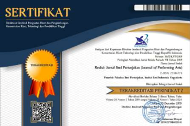Peran Emosi dalam Interpretasi Musikal Musisi untuk Meningkatkan Kinerja Estetis: Studi Kasus Pada Pemain Cello dan Gitar
Abstract
ABSTRACT The complex task in musical performance sometimes makes musicians get an unsatisfactory evaluation. On the other hand, the structural approach to music itself, which is believed to be a fundamental tool for musical interpretation, has not clear yet how its capacities could become the basis for translating written notes into musical sounds. Moreover, music is experienced not exclusively as a mere structure and sound event but also participated as a subjective event. This study, therefore, explores the role of musicians' personal experiences, particularly emotions, in shaping musical interpretation. It uses a qualitative method with a comparative approach. The approach is used to investigate how emotion can mediate the transformation of written notes into musical sounds. A comparison of two cases of interpretation on the cellist and the guitar player is held to explain if there are differences in the interpretation process of the two groups of musicians. The result of this study shows that, firstly, emotional experience gained in the socialization of everyday emotions plays an essential role in understanding music. Secondly, after musicians can apprehend the feeling in the musical structure, they can manifest them into an acoustic code that has an iconic relationship with the emotional content of the musical form. And thirdly, emotional experience posts as the basis for translating structural information into meaningful sound.
ABSTRAK Rumitnya tugas atau peran pemain musik membuat musisi terkadang mendapat evaluasi yang kurang memuaskan dari pendengar. Di sisi lain, pendekatan teoritis yang diyakini dapat menjadi alat bantu untuk menginterpretasi musik belum diketahui dengan jelas bagaimana musisi dapat menjadi basis dalam menerjemahkan nada-nada tertulis menjadi bunyi musikal. Padahal, musik dialami tidak hanya ekslusif sebagai peristiwa struktural dan bunyi semata, namun juga dialami sebagai peristiwa subjektif. Oleh sebab itu, penelitian ini mengeksplorasi peran pengalaman emosi subjektif pemain dalam membentuk interpretasi musikal. Penelitian ini menggunakan metode kualitatif dengan pendekatan komparatif. Pendekatan ini digunakan untuk mempelajari bagaimana emosi dapat menjadi perantara musisi dalam mentransformasi not tertulis menjadi bunyi musikal. Komparasi dua kasus interpretasi pada pemain cello dan pemain gitar dilakukan dalam rangka melihat apakah ada kemiripan dan perbedaan dalam proses menginterpretasi pada dua kelompok musisi intrumen yang berbeda. Hasilnya ditemukan bahwa pertama, pengalaman emosi yang diperoleh dalam sosialisasi emosi sehari-hari, berperan penting dalam memahami musik yang muatannya juga sarat dengan emosi. Kedua, setelah musisi dapat menangkap emosi yang terkandung dalam struktur musikal, musisi dapat merealisasikannya menjadi kode akustik yang memiliki relasi ikonikal dengan muatan emosi struktur musikal. Ketiga, pengalaman emosi menjadi basis dalam menterjemahkan informasi struktual menjadi bunyi yang bermakna.
Keywords
Full Text:
PDFReferences
Bower, C. M. (2002). The Transmission of Ancient Music Theory into the Middle Ages. In T. Christensen (Ed.), The Cambridge History of Western Music Theory (pp. 136–167). Cambridge: Cambridge University Press.
Cavett, E. (2022). Desire, gratification and the moment: a music analytical and psychological enquiry into the role of repetition in the music of Howard Skempton, with a response by the composer. Interdisciplinary Science Reviews, 1–20. https://doi.org/10.1080/03080188.2022.2035100
Dack, M. D. (2014). Philosophical Reflections on Expressive Music Performance. Dalam Fabian, Timmers, Schubert (ed.). 3-21.
Demos, Chaffin, dan L. (2017). Musicians body sway embodiesmusical structure and expression: A recurrence-based approach. Musicae Scientiae120.
Epstein, P. (1986). Pattern structure and process in Steve Reich’s piano phase. Musical Quarterly, 72(4), 494–502. https://doi.org/10.1093/mq/LXXII.4.494.
Ginting, E., & Irawati, E. (2021). Komunikasi Musikal Suling Dewa dan Memang dalam Ritual Bepelas pada Upacara Erau di Kutai Kartanegara. GETER : Jurnal Seni Drama, Tari Dan Musik, 4(1), 1–22. https://doi.org/10.26740/geter.v4n1.p1-22
Harsawibawa. (2017). Disrupsi dalam Musik. Resital: Jurnal Seni Pertunjukan (Journal of Performing Arts), 18(3), 133–143. DOI: https://doi.org/10.24821/resital.v18i3
Irawati, Eli. (2021). The Transmission of Resilience Learning in the Context of Formal Education an Ethnomusicological Review. Linguistics and Culture Review, 5 (S3), 1040-1053. https://doi.org/10.21744/lingcure.v5nS3.1664
Kamien, Roger. (2022). Music: An Appreciation. New York: McGraw Hill.
Kettle, M. (2018). Prom 42: Estonian Festival Orchestra/Järvi review – Pärt gripsbutBuniatishvilidisappoints. https://www.theguardian.com/music/2018/aug/ 14/estonian-festival-orchestra-jarvi-review-part-buniatishvili-prom-42
Krause, A. E., & North, A. C. (2019). Pop music lyrics are related to the proportion of female recording artists: Analysis of the United Kingdom weekly top five song lyrics, 1960-2015. Psychology of Popular Media Culture, 8(3), 233–242. https://doi.org/10.1037/ppm0000174
Lamont, A., & Loveday, C. (2020). A New Framework for Understanding Memories and Preference for Music. Music and Science, 3, 1–14. https://doi.org/10.1177/2059204320948315
Leung, M. C., & Cheung, R. Y. M. (2020). Music engagement and well-being in Chinese adolescents: Emotional awareness, positive emotions, and negative emotions as mediating processes. Psychology of Music, 48(1), 105–119. https://doi.org/10.1177/0305735618786421
Lewis, J. (2018). Julian Joseph Trio’s Tristan and Isolde review – updated, leaden and lifeless. https://www.theguardian.com/mu sic/2018/oct/07/tristan-andisolde- review-queen- elizabeth- halllondon-julian-joseph- trio-bbc-concert-orchestra97.
MacRitchie J, Buck B, dan B. N. (2013). Inferring Musical Structure TroughBodily Gestures. Musicae Sciantiae, 17(1), 86–108.
Meyer, Leonard B. (1956). Emotion and Meaning In Music. Chicago: University of Chicago.
Rahmat, Sujud Puji Nur., G.R. Lono Simatupang., Harsawibawa. (2017). Musik Metal dan Nilai Religius Islam: Tinjauan Estetika Musik Bermuatan Islami Dalam Penampilan Purgatory. Resital: Jurnal Seni Pertunjukan (Journal of Performing Arts), 18(3), 133–143. DOI: https://doi.org/10.24821/resital.v18i3
Sabbadini, A. (2002). Colour and music: Voices of the unconcious. International Journal of Psychoanalysis, 83(1), 263–266. https://doi.org/10.1516/8LXM-EF6L-Y0NN-M08K
Thompson MR dan Luck G. (2011). Exploring Relationships between Pianists’BodyMovements,TheirExpressive Intentio ns,and Structural Elementsof his Music. Musicae Sciantiae, 16(1), 19–40.
Willson, F. (2018). Siegfried review - blunt hero is hard tolike in a cluttered production. https://www.theguardian.com/mu sic/2018/oct/01/royal-opera- house-siegfried-review-keith- warner-ring-cycle
DOI: https://doi.org/10.24821/resital.v23i2.5075
Article Metrics
Abstract view : 0 timesPDF - 0 times
Refbacks
- There are currently no refbacks.
This work is licensed under a Creative Commons Attribution 4.0 International License.



